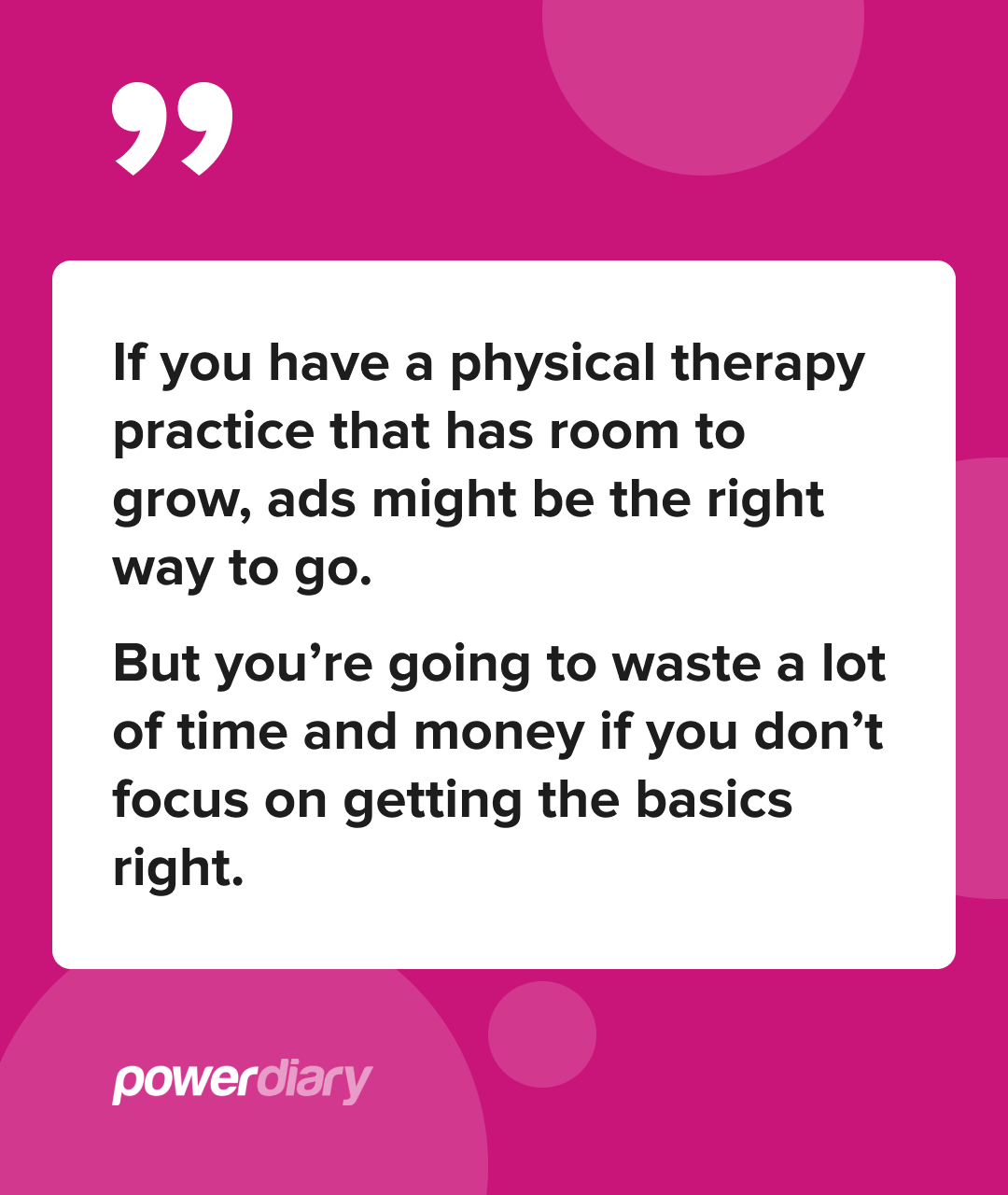Physical therapy ads are the bane of many physiotherapy practices. You know it’s important to keep advertising your practice to attract new clients, but it can be hard to “put yourself out there”. Especially when marketing and advertising have such negative connotations for health professionals who are generally much more focused on helping people rather running a slick business operation.
The good news is that it doesn’t have to be complicated. Ads for your physical therapy practice should be based on 4 underlying principles that can then be applied to the process of writing them.
The Underlying Principles of Great Ad Copy
1. Solve a Problem
This starts with your headline and continues into the body of your physical therapy ad, and it’s the area that most people overlook. We’re often so quick to let people know all the services we offer rather than taking a step back to try and work out what our clients actually need. Following the bridge-after-bridge copywriting formula, your ad headline needs to address the end goal of your visitor. You might think that users are clicking on your ad because it has the right keywords but, in reality, they’re clicking because it solves a problem they have. Don’t focus on your physical therapy ads on your service features and quality, rather let them know that you have the perfect solution for their issue – which leads onto the next point.
2. Focus on Benefits (Not Features)
One of my business mentors phrases it like this: “sell the sizzle, not the sausage”, and that’s what I try to keep in mind whenever I’m writing an ad copy. You don’t need to tell people how amazing your practice is; you need to tell them how your product will make their lives better.
Fortunately, that’s easy to do with a physical therapy practice as you’re in the business of improving your client’s quality of life, so it should be easy to write ad copy in such a way as to communicate the benefits of your offer.
Some things to focus on for your physical therapy ads might include:
- Using “you” in the copy to personalise your message;
- Sharing what outcomes the client can expect;
- Communicating if you accept Medicare or other payment options;
- Using specificity rather than generic wording.
Your client probably doesn’t mind what techniques or technology you use; they want to know that it will be effective and affordable. Benefits, not features (for example, will they be able to sleep better, keep up with the kids, get back to sports, etc).
3. Try to Elicit Emotion
Address the concerns of your target audience, rather than communicating information. If you have a limited number of characters (such as with Adwords), focus on how you help your clients, instead of information such as your practice location. It will help you to stand out from other competing ads and because you are triggering emotions in the viewer, they will be more likely to click on your ad.
Emotional ads perform well because they target your “emotional brain” rather than your “logical brain”. Ads that get the highest click-throughs elicit emotions such as anger, disgust, affirmation, and fear.
To write high-performing emotional ad copy, you need to identify your target customer and write emotionally-charged ads that pinpoint their deepest concerns. An example of physical therapy ads might include references to potentially irreversible damage without physical therapy treatment or the negative effects of an injury on your quality of life if not treated.
4. Create Urgency
Ever heard of FOMO? It doesn’t just apply to nights out. Creating urgency is key to writing effective ad copy for your physical therapy practice because it encourages people to take action. You may have convinced them that they need your services, but if there’s no urgency, you’re going to have much lower conversion rates.
The science of cognitive psychology (along with decision theory and behavioural economics) backs up this way of thinking which can be encapsulated in the expression that “losses loom larger than gains”. In other words, people tend to prefer to avoid losses more than acquiring an equivalent gain. Most people would prefer not to lose $5 than to find $5.
Ads that work the best, therefore, have time limits, which introduces scarcity and compels people to take immediate action.
Put the Principles into Practice
1. Write Compelling Headlines
Whether you’re writing ads for print or digital marketing channels, the most important aspect is your headline. It will be your headline that grabs attention and encourages the reader to continue – give the people that see your ad a strong reason to continue reading and get in touch.
2. Write Copy for Your Ideal Client
You’re probably not going to get it right the first time, but it’s important to use the underlying principles of great ad copy that we’ve outlined above to write for your ideal target market. You may have read the principles and agreed with them in theory, but it’s completely different when you’re applying them to the clients that you want to attract.
A good place to start might be your existing customers. Talk to clients that form your ideal target market and find out what lead them to your practice. Maybe it was fear – they have a knee ligament injury which wasn’t healing on its own, and they were concerned that it might have long-term consequences for their ability to run long distances. It could have been affirmation; they might have seen an ad from your practice that made them feel like their pain would be taken seriously and that you would work with them to resolve it.
This will help you put yourself in the shoes of your ideal customer, so you can narrow down which benefits to focus on, what emotions you want to try and trigger and what problems to solve in order to get potential clients to click-through on your ad.
3. Write a Showstopper Call-to-Action
Many businesses and brands, even those who have been writing ad copy for years, miss out on the power of a good call-to-action. You might have written the best headline and body content, but you have to compel your audience to click through. You don’t have to settle for a standard “Call Now” or “Find Out More”. Your CTA should start with a strong verb such as “download”, “subscribe” or “Book”, it can include emotional appeal, USP, urgency, and even a little creativity.
4. Split-Test
If you’re running online physical therapy ads, you need to split test your headings, body copy, and CTAs by running multiple copies of your ad with different variations to find out which is the most effective (i.e. highest converting). There are so many different approaches you can try, from asking questions, to adding humour, statistics, your unique selling proposition, and more. But you won’t know what works best for your practice if you aren’t testing different options.
5. Learn from the Professionals
You’re not the first person to run ads, there are agencies and brands that are spending hundreds of thousands of dollars a month on ads, so why not learn from them? Neil Patel and Larry Kim are a great place to start. And, while you’re at it, have a look at the type of ads that other physical therapists are running to get an idea of what works for your target market.
If you have a physical therapy practice that has room to grow, ads might be the right way to go. But you’re going to waste a lot of time and money if you don’t focus on getting the basics right. This crash course on ad copywriting is a good start to help you hone your content and will give you a strong base to work from when you start running ads.
Are you ready to start your marketing journey? Here is The Complete Guide to Physical Therapy Marketing.







